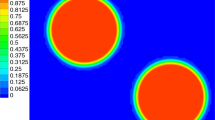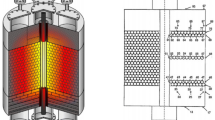Abstract
Exothermic reactor is the main part in a chemical heat pump. It involves complex multi-component exothermal chemical reaction in catalyst-filled porous media. The lattice Boltzmann method (LBM) is developed to simulate the characteristics of fluid flow, heat and mass transfer coupling chemical reaction in the exothermic reactor of the isopropanol/acetone/hydrogen chemical heat pump system. Fractal theory is used to structure a porous medium model in the reactor. The simulation results show that LBM is suitable for the simulation and the conversion has an optimal value with different inlet velocities.
Similar content being viewed by others
Abbreviations
- CHP:
-
Chemical Heat Pump
- LBM:
-
Lattice Boltzmann Method
- c :
-
Lattice speed [m/s]
- c p :
-
Specific heat capacity [J/(kg·K)]
- D :
-
Mass diffusivity coefficient [m2/s]
- e:
-
Lattice particle speed
- k e :
-
Reaction equilibrium constant [1/Pa2]
- K r :
-
Reaction coefficient [mol/(m2·s·Pa2)]
- L 0 :
-
Characteristic length [m]
- M :
-
Mole weight
- Q :
-
Reaction heat [J/mol]
- R react :
-
Reaction rate [mol/(m2·s)]
- Δt :
-
Time step
- T :
-
Temperature [K]
- T 0 :
-
Characteristic temperature [K]
- U:
-
Macroscopic velocity[m/s]
- U 0 :
-
Characteristic velocity [m/s]
- x :
-
Position in space
- X :
-
Distribution function
- α :
-
Thermal diffusivity coefficient [m2/s]
- ɛ :
-
Porosity
- λ :
-
Stoichiometric coefficient
- ν :
-
Kinetic viscosity [m2/s]
- ρ :
-
Density [kg/m3]
- τ :
-
Relaxation time
- ω :
-
Weight coefficient
- eq :
-
Equilibrium
- *:
-
Source term
- σ :
-
Chemical component
- ace :
-
Acetone
- hydro :
-
Hydrogen
- I :
-
Discrete velocity direction
- ip :
-
Isopropanol
- mix :
-
Mixture
- σ :
-
Chemical component
References
Ajah, A.N., Mesbah, A., Grievink, J., Herder, P.M., Falcao, P.W., and Wennekes, S., 2008, “On the Robustness, Effectiveness and Reliability of Chemical and Mechanical Heat Pumps for Low-Temperature Heat Source District Heating: A Comparative Simulation-Based Analysis and Evaluation” Energy, 33(6), pp. 908–929.
Basagaoglu, H., Meakin, P., Succi, S., and Welhan, J., 2006, “Boundary Effects on the Onset of Nonlinear Flow in Porous Domains”, Europhysics Letters, 73(6), pp. 858–863.
Succi, S., Foti, E. and Higuera, F., 1989, “Three-Dimensional Flows in Complex Geometries with the Lattice Boltzmann Method”, Europhysics Letters 10(5), pp.433–438.
Spaid, M.A.A. and Phelan, F.R., 1997, “Lattice Boltzmann Methods for Modeling Microscale Flow in Fibrous Porous Media”, Physics of Fluids, 9(9), pp.2468–2474
Alazmi, B., and Vafai, K., 2001, “Analysis of Fluid Flow and Heat Transfer Interfacial Conditions between a Porous Medium and a Fluid Layer”, International Journal of Heat and Mass Transfer, 44(9), pp.1735–1749.
Chen, S., Dawson, S.P., Doolen, G.D., Janecky, D.R., and Lawniczak, A., 1995, “Lattice Methods and Their Applications to Reacting Systems”, Computers & Chemical Engineering, 19(6–7), pp. 617–646.
Huber, C., Chopard, B. and Manga, M., 2010, “A Lattice Boltzmann Model for Coupled Diffusion”, Journal of Computational Physics, 229(20), pp. 7956–7976.
Kao, P.H., Ren, T.F. and Yang, R.J., 2007, “An Investigation into Fixed-Bed Microreactors Using Lattice Boltzmann Method Simulations”, International Journal of Heat and Mass Transfer, 50(21–22), pp. 4243–4255.
Yu, H., Luo, L. and Girimaji, S.S., 2002, “Scalar Mixing and Chemical Reaction Simulations Using Lattice Boltzmann Method”, International Journal of Computational Engineering Science 01(3), pp.73–88.
Succi, S., 2001, The Lattice Boltzmann Equation for Fluid Dynamics and Beyond, Clarendon Press, Oxford.
Peng, Y. and Schaefer, L., 2006, “A Thermal Lattice Boltzmann Two-Phase Flow Model and Its Application to Heat Transfer Problems — Part 1. Theoretical Foundation”, Journal of Fluids Engineering-Transactions of the ASME, 128(1), pp. 142–150.
Sukop, M.C. and Thorne, D.T., 2006, Lattice Boltzmann Modeling: An Introduction for Geoscientists and Engineers, Springer, Berlin.
Author information
Authors and Affiliations
Additional information
This work was supported by the National Natural Science Foundation of China (Grant No.51106158) and the National Basic Research Program of China (Grant No. 2011CB710705)
Rights and permissions
About this article
Cite this article
Xin, F., Li, XF., Xu, M. et al. Simulation of gas exothermic chemical reaction in porous media reactor with lattice Boltzmann method. J. Therm. Sci. 22, 42–47 (2013). https://doi.org/10.1007/s11630-013-0590-5
Received:
Published:
Issue Date:
DOI: https://doi.org/10.1007/s11630-013-0590-5




